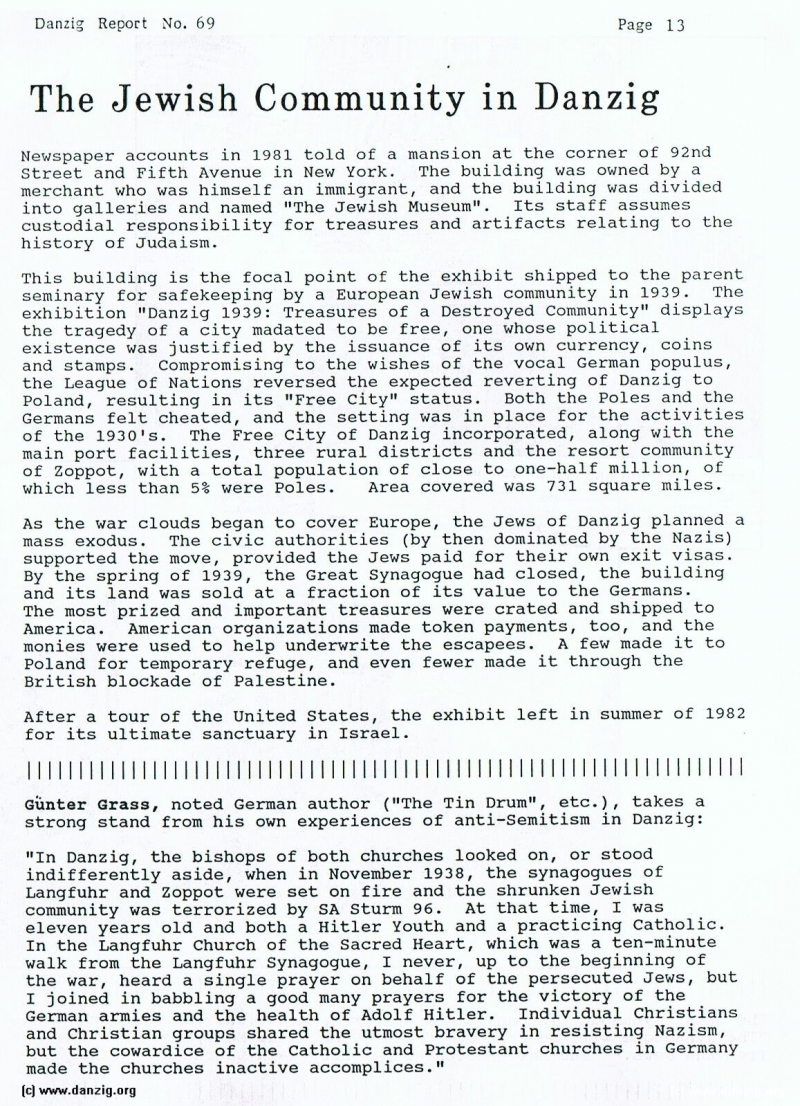
The Jewish Community in Danzig
Newspaper accounts in 1981 told of a mansion at the corner of 92nd Street and Fifth Avenue in New York. The building was owned by a merchant who was himself an immigrant, and the building was divided into galleries and named “The Jewish Museum”. Its staff assumes custodial responsibility for treasures and artifacts relating to the history of Judaism.
This building is the focal point of the exhibit shipped to the parent seminary for safekeeping by a European Jewish community in 1939. The exhibition “Danzig 1939: Treasures of a Destroyed Community” displays the tragedy of a city madated to be free, one whose political existence was justified by the issuance of its own currency, coins and stamps. Compromising to the wishes of the vocal German populus, the League of Nations reversed the expected reverting of Danzig to Poland, resulting in its “Free City” status. Both the Poles and the Germans felt cheated, and the setting was in place for the activities of the 1930’s. The Free City of Danzig incorporated, along with the main port facilities, three rural districts and the resort community of Zoppot, with a total population of close to one-half million, of which less than 5% were Poles. Area covered was 731 square miles.
As the war clouds began to cover Europe, the Jews of Danzig planned a mass exodus. The civic authorities (by then dominated by the Nazis) supported the move, provided the Jews paid for their own exit visas. By the spring of 1939, the Great Synagogue had closed, the building and its land was sold at a fraction of its value to the Germans. The most prized and important treasures were crated and shipped to America. American organizations made token payments, too, and the monies were used to help underwrite the escapees. A few made it to Poland for temporary refuge, and even fewer made it through the British blockade of Palestine.
After a tour of the United States, the exhibit left in summer of 1982 for its ultimate sanctuary in Israel.
Günter Grass, noted German author (“The Tin Drum”, etc.), takes a strong stand from his own experiences of anti—Semitism in Danzig:
“In Danzig, the bishops of both churches looked on, or stood indifferently aside, when in November 1938, the synagogues of Langfuhr and Zoppot were set on fire and the shrunken Jewish community was terrorized by SA Sturm 96. At that time, I was eleven years old and both a Hitler Youth and a practicing Catholic. In the Langfuhr Church of the Sacred Heart, which was a ten-minute walk from the Langfuhr Synagogue, I never, up to the beginning of the war, heard a single prayer on behalf of the persecuted Jews, but I joined in babbling a good many prayers for the victory of the German armies and the health of Adolf Hitler. Individual Christians and Christian groups shared the utmost bravery in resisting Nazism, but the cowardice of the Catholic and Protestant churches in Germany made the churches inactive accomplices.’
Danzig Report Vol. 1 - Nr. 69 - October - November - December - 1990, Page 13.
Hits: 3303
Added: 29/06/2015
Copyright: 2025 Danzig.org

